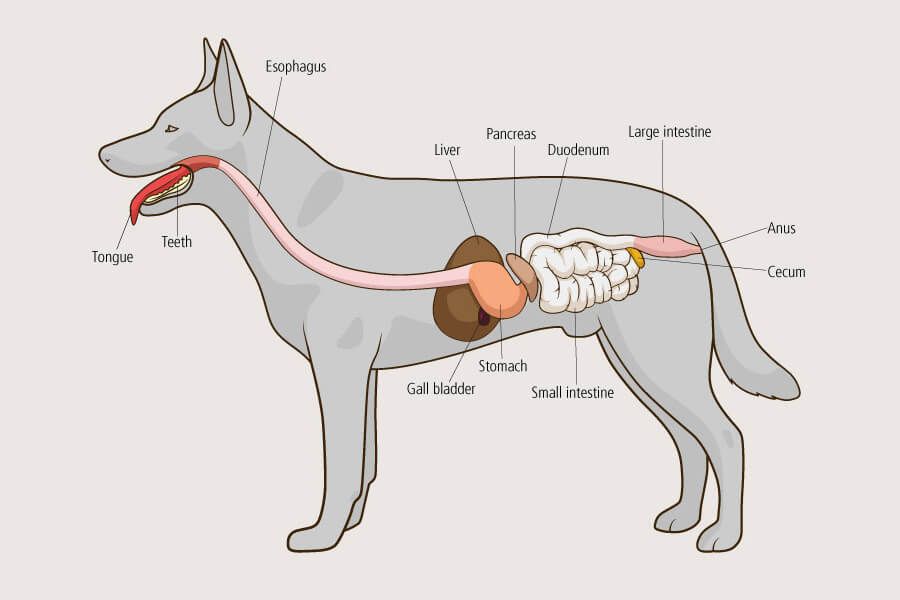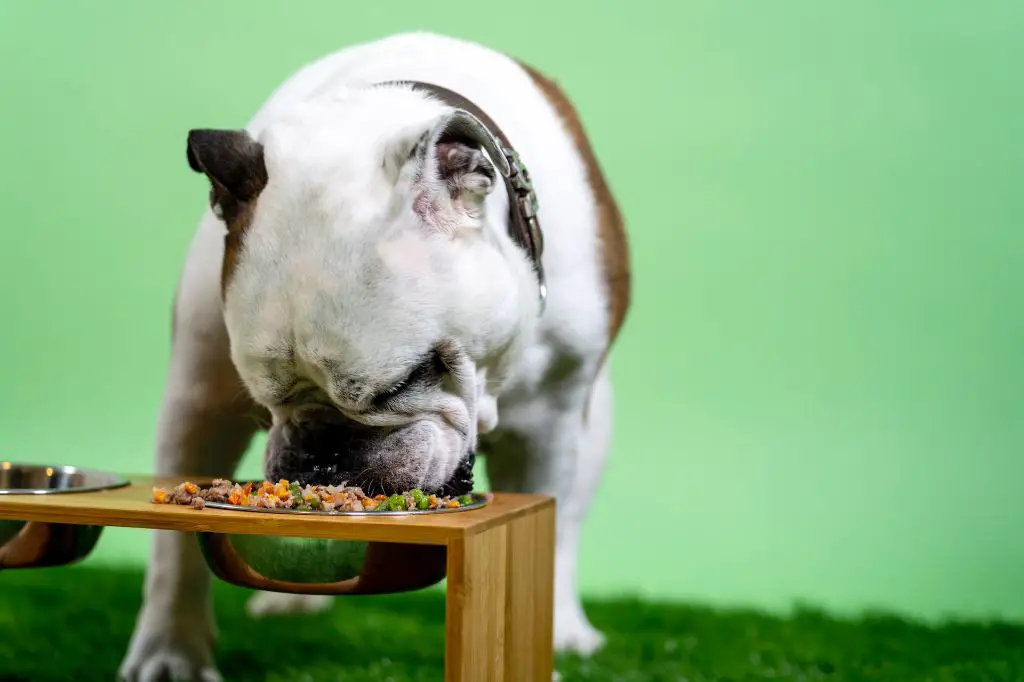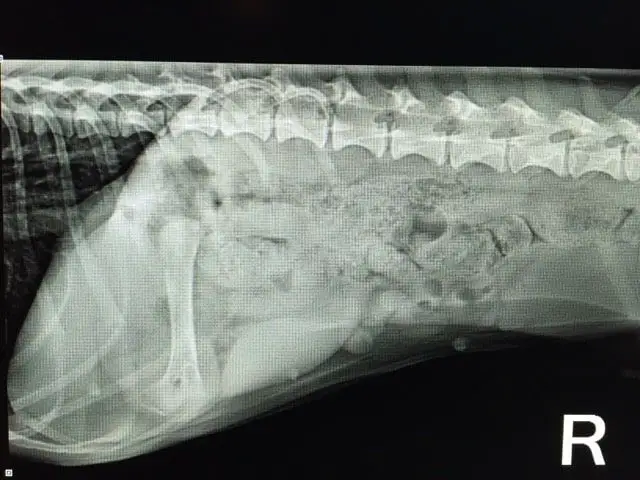Introduction
Dogs are specialized carnivores that have evolved to eat and digest bones as part of their natural diet. While eating the flesh and bones of prey is healthy for dogs, the concept of bones breaking down in the stomach often concerns pet owners. This article examines what happens when dogs eat bones, including whether or not they fully break down in the stomach.
We’ll take a close look at a dog’s digestive system and how their teeth, stomach acid, and digestive process are adapted for eating bones. This includes key factors like bone composition and differences between cooked and raw bones. To give dog owners guidance, we’ll cover veterinarian recommendations on bone safety and alternatives for providing your dog their nutritional needs.
By the end, you’ll understand if bones can break down in a dog’s stomach and how feeding bones impacts their health and wellbeing.
Dog Digestive System

A dog’s digestive system is designed to extract nutrients and energy from food in order to fuel their body. It begins at the mouth, where dogs use their teeth and jaws to chew and break down food. The saliva in their mouth helps soften and lubricate the food to make swallowing easier.
After swallowing, the chewed food travels down the esophagus and into the stomach. The stomach contains hydrochloric acid and digestive enzymes that continue breaking down food both mechanically and chemically. The stomach muscles churn and contract to further digest the food into a semi-liquid state.
The partially digested food then moves from the stomach into the small intestine, where the majority of nutrient absorption occurs. Here, the liver, gallbladder, and pancreas produce bile and digestive juices that facilitate absorption. The remaining indigestible food moves into the large intestine, where water is reabsorbed before waste is eliminated through the anus.
Teeth and Chewing
Chewing is an important part of the digestive process for dogs. Dogs have molars and premolars in the back of their mouths that are specially designed for grinding, crushing and chewing food into smaller pieces. Their jaws move in a vertical motion, exerting roughly 30 to 40 pounds of pressure per square inch, enabling them to break down bones, raw meat and other fibrous foods.

When dogs chew thoroughly, it starts the digestion process by mixing the food with saliva. The salivary enzymes then begin breaking down carbohydrates and fats. Thorough chewing also helps avoid digestive issues, as large pieces of food entering the stomach can cause upset or blockages. Swallowed bones that are not properly chewed and fragmented can be dangerous.
So a dog’s powerful jaws and teeth allow it to chew food extensively before swallowing. This initial mechanical breakdown of food by chewing is a key first step in digestion and ensures the stomach acids and enzymes can work efficiently.
Stomach Acid
Dogs have extremely acidic stomachs with pH levels between 1 and 2. In comparison, human stomachs have a pH between 3 and 5. The high acidity is important for digestion as it helps to breakdown food, kill bacteria, and activate enzymes.
The hydrochloric acid in a dog’s stomach is much stronger than household acids and can dissolve things like bones. The strong acid combined with muscular contractions churns and liquefies food into an acidic liquid called chyme. This allows the nutrients to be absorbed in the small intestine.
While a dog’s acidic stomach can breakdown bone fragments, it is not recommended to give dogs bones to chew or eat. The stomach acid can cause problems if sharp pieces of bone get lodged or too much inorganic calcium builds up from bones.
Bone Composition
Bones are made up of a complex combination of materials that provide strength and structure. The primary components are:

- Collagen – This protein gives bones flexibility and accounts for about 30% of bone mass.
- Calcium phosphate – The mineral component made up of hydroxyapatite provides hardness and rigidity. It makes up around 60% of bone.
- Water – Accounts for approximately 10% of bone mass.
The collagen fibers are impregnated with crystalline hydroxyapatite deposits, which hardens the collagen matrix and gives bone its rigid structure. The collagen provides elasticity, while the calcium phosphate offers compressive strength. This unique composite structure allows bones to be rigid and strong yet flexible enough to withstand stresses.
Cooked vs Raw Bones
There are important differences in how cooked and raw bones break down. Raw bones are more pliable and softer, allowing dogs to chew them into smaller pieces that can be digested. The natural enzymes in a dog’s saliva help break down the raw bone.
In contrast, cooked bones become harder and more brittle. The high temperatures degrade the bone’s natural collagen, causing cooked bones to splinter into sharp shards during chewing. These shards can then get stuck in a dog’s throat or puncture their digestive tract.
Veterinarians typically recommend raw meaty bones for dogs, as the more pliable raw bones are safer. Cooked bones are not recommended, as they can splinter and pose a significant choking hazard or internal injury risk to dogs.
Bone Fragments
While larger bones may pass through a dog’s digestive system intact, bones often splinter into fragments during the chewing process. These shards of bone can pose significant dangers if swallowed by dogs.

Sharp pieces of bone may lacerate or puncture a dog’s mouth, throat, stomach, or intestines as they pass through the gastrointestinal tract. Even small fragments may cause internal injuries or become embedded in the delicate tissues of the esophagus or digestive system.
If the bone pieces are very sharp and rigid, they can potentially rupture organs or blood vessels, leading to potentially fatal conditions like peritonitis. Embedded bone fragments may also lead to obstructions or even perforations in the intestines.
Some bone pieces, especially from weight-bearing bones like chicken leg bones, are dense enough to resist digestion. These fragments may accumulate in the stomach or intestines, irritating the gastrointestinal lining. Such irritation can cause vomiting, diarrhea, loss of appetite, and other digestive issues.
Thus, bone fragments pose a clear and significant danger to a dog’s gastrointestinal health. Owners should be cautious about allowing dogs to chew on bones, especially cooked bones, that may splinter.
Veterinarian Guidance
Most veterinarians highly discourage giving dogs any sort of bones, whether they are cooked or raw. Bones pose serious risks to dogs, including:
- Fractured teeth from chewing on bones
- Choking from pieces of bone getting lodged in the throat
- Digestive obstructions from bone fragments or shards
- Internal organ damage or perforations from sharp bone edges.
While some dog owners believe bones are a natural food source and important for dental health, the risks generally outweigh potential benefits according to veterinary professionals. They recommend avoiding bones altogether and opting for safer chews or dental care alternatives like brushing.
If you choose to give a bone despite the risks, veterinarians emphasize close supervision and taking the bone away after 10-15 minutes once it starts splintering. Only large raw marrow bones are considered somewhat safer options, but cooked bones should always be avoided.
For optimum canine health and safety, consult your veterinarian about appropriate treats, chews, and dental care for your dog.
Safe Alternatives
While bones can pose risks to dogs, there are many safe alternatives for chewing and dental health. Here are some popular options:
-
Rawhides – These are made of digestible rawhide or vegetarian ingredients. Look for treats labeled “digestible” and avoid flavored varieties.
-
Bully sticks – These are made from beef pizzle and digest easily. Opt for single-ingredient bully sticks without artificial flavors.
-
Dental chews – These nylon or rubber chews are designed to scrape plaque and tartar off teeth. Make sure they are the appropriate size for your dog.
-
Edible chews – Choices include dried sweet potato, yak chews, and Himalayan chews. These will occupy dogs for hours of chewing fun.
-
Rubber toys – Non-edible rubber or silicone toys can also satisfy chewing urges without being swallowed.
Dog owners have many safe options to consider before giving real bones. With supervision and the right chew toys, you can keep your dog’s teeth clean without the risks.
Conclusion
In summary, bones should not be given to dogs as oral health chews or treats because they can fracture teeth and become a choking hazard. While a dog’s stomach acid can break down bone fragments, these shards can still puncture or lacerate the digestive tract on the way through. Raw bones splinter more easily than cooked bones and should especially be avoided. Safe alternatives for dogs include bully sticks, rubber chews, food-stuffed puzzle toys, and specially formulated dental treats. If you choose to give bones, only select larger weight-bearing cooked bones and supervise your dog closely. Otherwise it’s best to avoid bones altogether and opt for gentler chewing outlets to promote dental health.